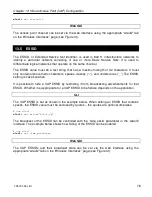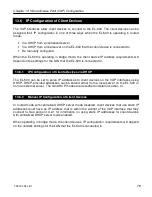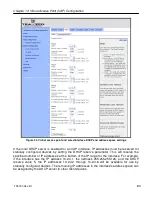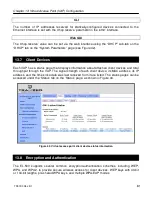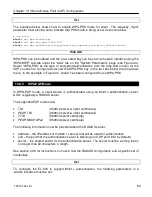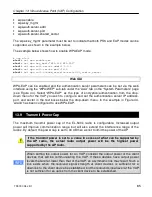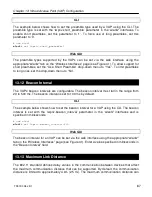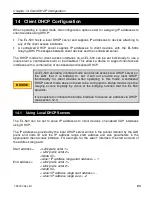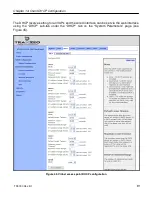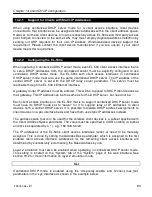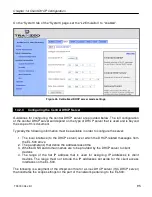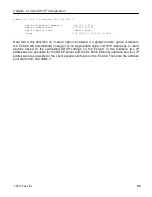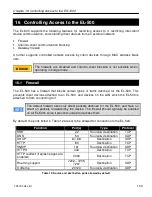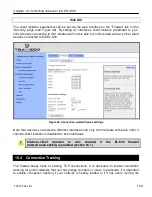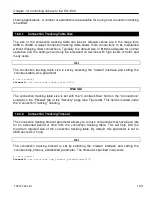
Chapter 14: Client DHCP Configuration
TR0190 Rev. B1
92
14.2 Using a Centralized DHCP Server
Centralized DHCP server mode uses DHCP relaying to enable assignment of IP addresses to
wireless client devices from a common remote DHCP server. The remote DHCP server may
reside either on a host connected to the LAN segment that the EL-500’s Ethernet is attached
to, or on a server that is beyond one or more routers. When using a common DHCP server,
wireless client devices are assigned IP addresses from a single address pool, and are allowed
to keep their IP address while roaming seamlessly from AP to AP.
There are three classes of entities that must be configured when using this DHCP mode:
1. The EL-500
2. The central DHCP server
3. Any intermediate router(s) in the path between the DHCP server and the EL-500
When using a centralized DHCP server, a Client Address Space (CAS), from which client
device IP addresses are assigned, must be defined. The active VAP client access interfaces
on the EL-500 (there can be up to 4 per EL-500) must also have IP addresses that fall within
the CAS. This is to facilitate DHCP relay and selection of client device IP addresses from the
correct DHCP scope on servers that serve hosts connected to different subnets. The VAP
client access interface IP addresses must be configured statically and must be contiguous. It is
recommended that a contiguous range of IP addresses at either the beginning or the end of
the CAS be set aside, one for each VAPs on the EL-500.
The Client Address Space (CAS) is not equivalent to the range of addresses
served by the DHCP server. The DHCP-served address range is a subset of the
CAS. The CAS must also include the addresses for the client access interfaces
and the address of the EL-500’s Ethernet interface.
Consider the example where an EL-500 has all four of its VAPs enabled. The DHCP server
resides on a host that also acts as the WAN router and is connected to the same LAN segment
that the EL-500’s wired interface is. We will set aside 4 IP addresses for the EL-500’s VAPs.
Assuming the client address space is 192.168.5.0/24, with available addresses from
192.168.5.1 to 192.168.5.255, we will use 192.168.5.1 for the server hosting the DHCP server,
192.168.5.2 for the EL-500’s Ethernet interface, set aside 192.168.5.3 to 192.168.5.6 for the
EL-500’s VAP interfaces, and configure the remote DHCP server to serve IP addresses in the
range of 192.168.5.7 to 192.168.5.254 to wireless client devices. We will keep 192.168.5.255
as the broadcast address.
A bridged EnRoute1000 will pass DHCP traffic through its wired interface to any
client devices on its VAPs regardless of the EnRoute1000’s DHCP mode settings.
Centralized DHCP mode provides similar capability for an EnRoute1000 in routed
mode, while adding the capability to support different subnets, a firewall, and
QoS, which are not available in bridge mode.
Summary of Contents for EL-500
Page 20: ...Chapter 3 Using the Web Interface TR0190 Rev B1 20 Figure 8 Rebooting the EL 500...
Page 68: ...Chapter 11 Ethernet Interface Configuration TR0190 Rev B1 68 Figure 38 Wired DHCP settings...
Page 108: ...Chapter 16 Controlling Access to the ER 1000 TR0190 Rev B1 108 Figure 50 VAP ACL configuration...

